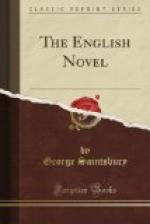a hundred years later and was asked about a hundred
years before), “Is it not amazing that the [two]
most licentious writers of romance are women?”
And it starts with a burlesque account of a certain
Margaret Marsham who exclaims, “What then? to
add to my earthly miseries am I to be called Peggy?
My name is Margari_tt_a!” “I am sure that
if I am called Peggy again I shall go into a fit.”
But this promise of something to complete the trio
with
Northanger Abbey and
The Heroine
(to be presently mentioned) is not maintained.
Not only does the writer force the note of parody
too much by making “Margaritta” say to
herself, “Poor persecuted
dove that I
am,” and adore a labourer’s shirt on a
hedge, but she commits the far more fatal fault of
exchanging her jest for earnest. Margaritta—following
her romance-models—falls a victim to an
unprincipled great lady and the usual wicked baronet—at
whose head, one is bound to say, she flings herself
with such violence as no baronet could possibly resist.
Her sister Mary, innocent of romance-reading and all
other faults, is, though not as guilty, as unlucky
almost as Margaret: and by far the greater part
of the book is an unreal presentment, in nearly the
worst manner of the eighteenth century itself, of
virtuous curates,
unvirtuous “tonish”
rectors, who calmly propose to seduce their curates’
daughters (an offence which, for obvious reasons,
must, in the worst times, have been unusual), libertine
ladies, and reckless “fashionables” of
all kinds. The preface and the opening create
expectations, not merely of amusement but of power,
which are by no means fulfilled. It is “S.G.”
who asserts that
Ida of Athens “has brought
a blush to the cheek of many,” and one can only
repeat the suggested substitution.
The only faults that can be found with The Heroine
or The Adventures of Cherubina, by Eaton Stannard
Barrett, which appeared in the same year, with no
very different object and subject, though written in
lighter vein, are one that it could not help and another
that it could. Unjustly, but unavoidably, the
first is the worst. That it is a burlesque rather
overdone—a burlesque burlesque—not
in the manner of Thackeray, but in that of some older
and some more recent writers—is unfortunate,
but not fatal. One can forgive—one
can even enjoy—the ghost who not only sneezes
but says, “D—n, all is blown!”
When the heroine is actually locked up with a man
in a chest one is more doubtful: recovering when
the Marquis de Furioso, “bowing gracefully to
the bride,” stabs himself to the heart, which
is almost “the real Mackay” as they say
in the North. The slight awkwardness of snow falling
the day after the characters have been eating strawberries
does not amuse us much, because this is a comparatively
ordinary event of the early twentieth century, whatever
it might be of the early nineteenth. But what
is fatal, though the author could not help it, is that
the infinitely lighter, more artistic, and more lethal
dart of Northanger Abbey had been launched
by the pen, if not the press, more than a dozen years
before.




